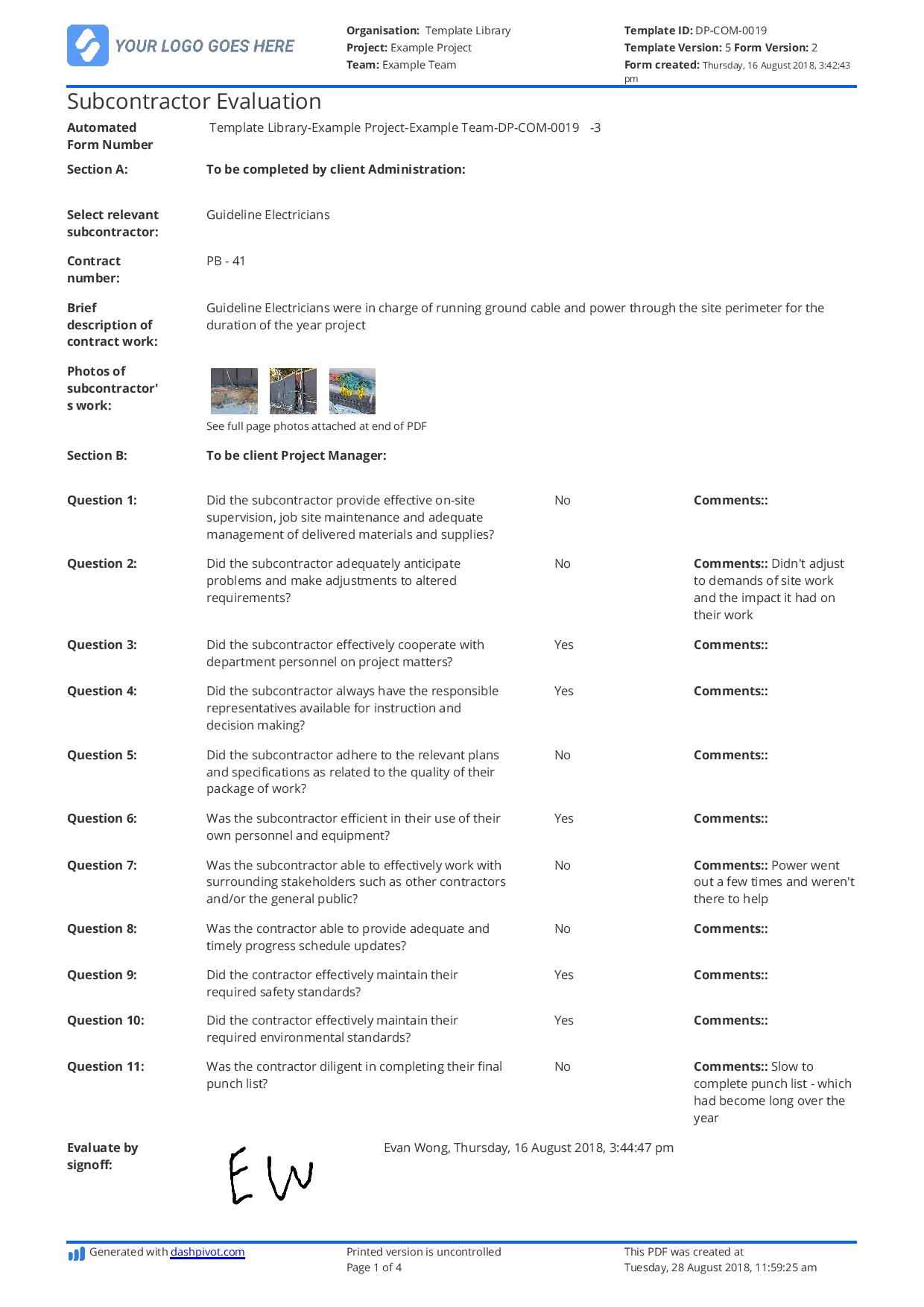Commercial – Subcontractor evaluation criteria
Subcontractor evaluation criteria: Here's what you need to include in your procedure
In this article, we go through the key subcontractor evaluation criteria you need to use, giving you a clear list of what to look for and pick the best people and keep things running smoothly on-site.

About subcontractor evaluations
Doing and receiving subcontractor evaluations isn't anyone favourite part of the job (except when the feedback is resoundingly positive). In fact, being analysed in general isn't all that enjoyable, nor is paying judgement to a person or company. But there is an underlying need for subcontractor evaluation which runs deeper than checking checkboxes or giving someone a pat on the back or slap on the wrist.
Subcontractor evaluations are one of the most powerful forms of checks and balances that contractors and other subcontractors have in the industries.
Subcontractor evaluations serve as the main source of 'review' in the industries, allowing each company to see how subcontractors are performing for them and notice patterns of performance or red flags; enabling the rated subcontractors to understand how they are performing; and to enable companies and projects across the industries to reward the good work of high performing subcontractors.
Because of their importrance, it's critical that the review system for all subcontractors is as standardised and fair as possible. Companies should work hard to ensure that their subcontractor evaluation process is as objective as possible - for everyones sake.
The most important way to create a fair scoring system is to create a standardised evaluation checklist or form which references criteria which is applicable across all (ar at least most) criteria. This criteria should be general enough to be applicable across a number of specialisations but specific enough to speak to and pick up any issues.
Here's a subcontractor evaluation example
A standard and reliable subcontractor evaluation process will include completing and sharing a subcontractor evaluation checklist or document. The form below is an example of that your subcontractor evaluation may look like.
The form should cover some general record keeping rules like the contractor number and description of contract work to provide context and understanding, the rest of the evaluation forms the main criteria and structure of the actual performance rating.
Take a look at the example below, and then read on to read more about each set of criteria and what makes that important to the assessment.

Use and customise this subcontractor evaluation template for free.
What to include in your subcontractor evaluation criteria...
Criteria 1) Did the subcontractor provide effective on-site supervision, job site maintenance and adequate management of delivered materials and supplies?
Construction and industrial project performance centres very closely on the management of moving parts. Each subcontractor is responsible of their own performance, and how their performance fits into the larger project picture. This criteria showcases a number of elements of the subcontractors performance which highlight if the subcontractor showed care for their work and an understanding of the importance to maintain high standards and attention to detail across their teams, work and materials.
Criteria 2) Did the subcontractor adequately anticipate problems and make adjustments to altered requirements?
Projects rarely go to plan, and most companies don't expect them to do so. This makes anticipating developments and potential problems a critical part of performance. Some of these problems may be associated with the subcontractor or with other parties, but every party is in the project together and each party should be looking to solve problems and make proactive decisions before they become serious and impactful issues.
Criteria 3) Did the subcontractor effectively cooperate with department personnel on project matters?
As we have mentioned, the performance of a single subcontractor is tightly interconnected with the performance of others. Cooperation with other parties and department personnel on project matters ensure that the subcontractor is easy and pleasant to work with, which is a critical part of getting the job done (and getting future work).
Criteria 4) Did the subcontractor always have the responsible representatives available for instruction and decision making?
Resourcing is a critical part of project success. Each subcontractor needs to ensure that they have the necessary people available on site to make good decisions and receive and interpret instructions. While a subcontractor may not intentionally under-resource their team or the project, doing so can impact project success and make it incredibly hard for contractors and other stakeholders to communicate with subcontractors effectively.
Criteria 5) Did the subcontractor adhere to the relevant plans and specifications as related to the quality of their package of work?
While projects rarely if ever go to 'plan', the subcontractor must still adhere to the original plan until instructed not to do so - and must maintain the quality and standard of their work inline with the specifications set out in the original contract.
Criteria 6) Was the subcontractor efficient in their use of their own personnel and equipment?
How a subcontractor manages their people and equipment is important for performance, but also important for the inventory and financial wellbeing of contractors and other project stakeholders. Where possible (or where specified), a subcontractor should be utilising and relying on their own resources to 'get the job done' properly.
Criteria 7) Was the subcontractor able to effectively work with surrounding stakeholders such as other contractors and/or the general public?
A subcontractor who performs work to a high standard is great. But that's only part of the project battle. Managing relationships with the public and other stakeholders is very important too. Getting work done quickly and to standard isn't any good if it upsets and frustrates local communities or authorities. Finishing two days of work in one day is great, if work is started and ended at the appropriate times as not to disturb residence or disobey local noise ordinances. Every subcontractor must consider the impacts of the way they work.
Criteria 8) Was the contractor able to provide adequate and timely progress schedule updates?
Keeping contractors, clients and other stakeholders across what's happening on the project is critical. In order to understand progress, see obstacles and make informed decisions, each party needs to have a deep and recent understanding of what's happening. It's each subcontractors job to document and share their progress effectively.
Criteria 9) Did the contractor effectively maintain their required safety standards?
Safety is an important internal consideration for contractors and subcontractors, but it's also important across projects. Safety issues can get projects shut down or paused, and can put other parties into awkward and dangerous situations. Safety is an integral part of performance.
Criteria 10) Did the contractor effectively maintain their required environmental standards?
Similar to the above, subcontractors must also be conscious of and align their own standards with the expectations of the project and contractor. Environmental issues are becoming more central to projects and will become an even more heavily weighted piece of criteria in the years to come as the environment becomes a larger and larger piece of project work and final delivery.
Criteria 11) Was the contractor diligent in completing their final punch list?
Subcontractors make mistakes, and their mistakes often don't necessitate 'consequences ' in the form of low scores. In fact, on projects, subcontractors often get a number of 'chances' to correct their issues and defects, often in the form of punch or snag lists. How subcontractors clean up and complete their punch lists shows how diligent they are, how much they care about their own standards, and shows their ability to deliver quality final work.
You may want to include criteria which fall outside of these core parameters, or you may be happy operating within these constraints. The subcontractor evaluation checklist assessment template below comes pre-built with these criteria, so feel free to get started with that and add, subtract or edit form fields as you see fit. Hopefully it is flexible enough and thorough enough to make sense across your projects, and will form part of your standardised and fair subcontractor evaluation criteria and process now and in the future.

Subcontractor Evaluation Checklist template
Record and share subcontractor performance for the benefit of all with this reliable checklist.

Meeting Minutes template
Evaluate and share contractor performance in a standardised and fair manner.

Site Diary template
Complete & organise your daily diaries more efficiently.